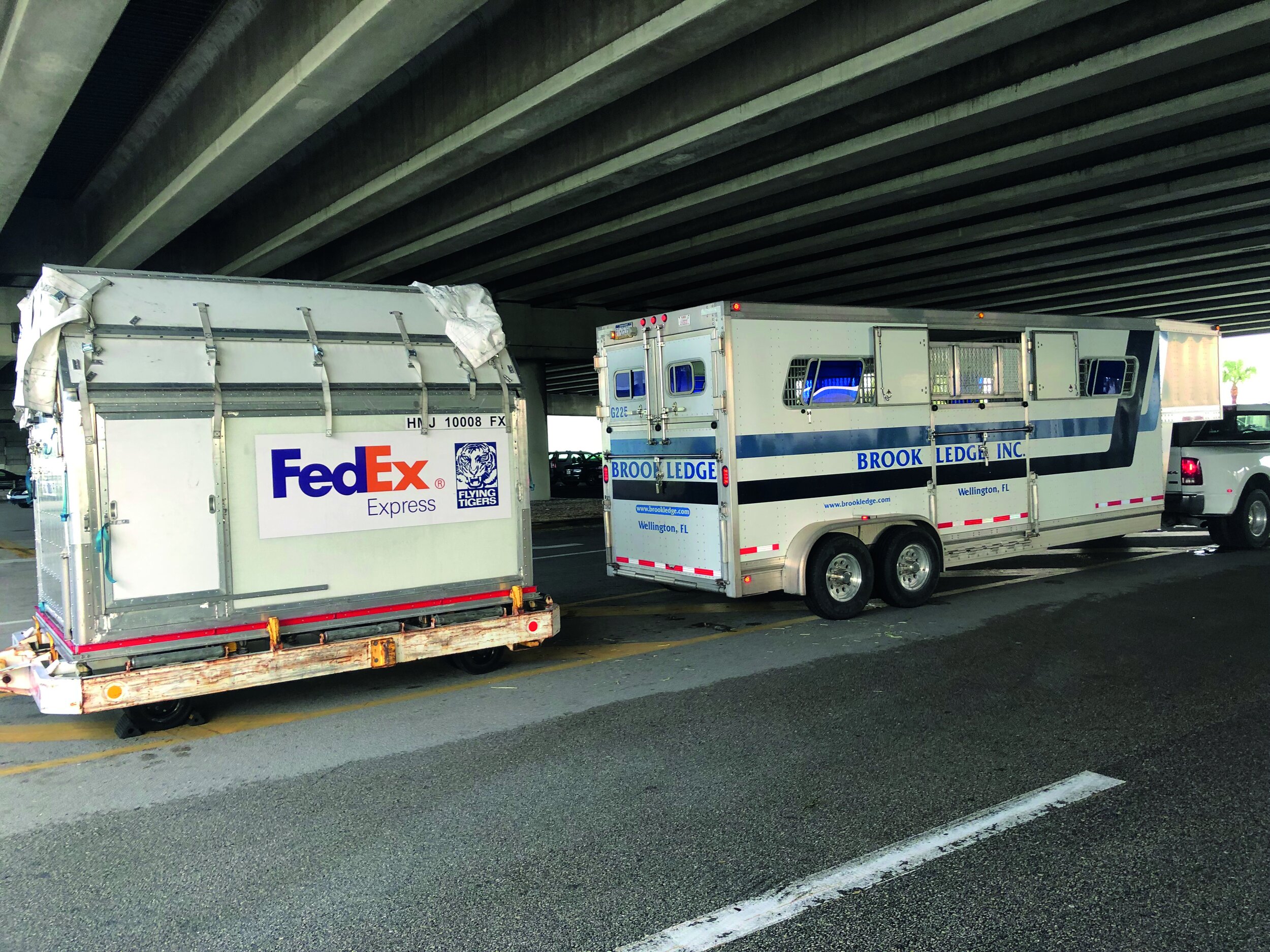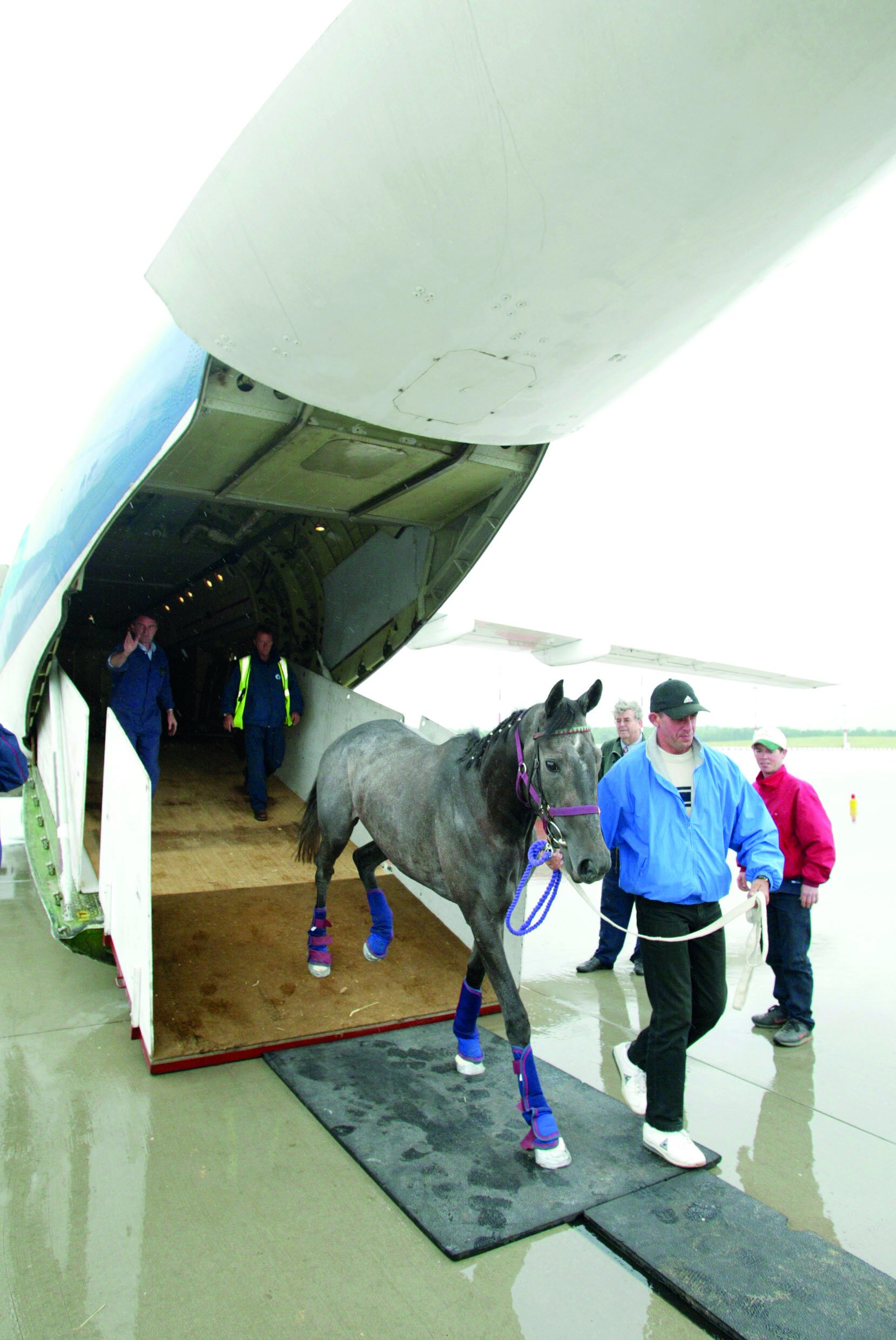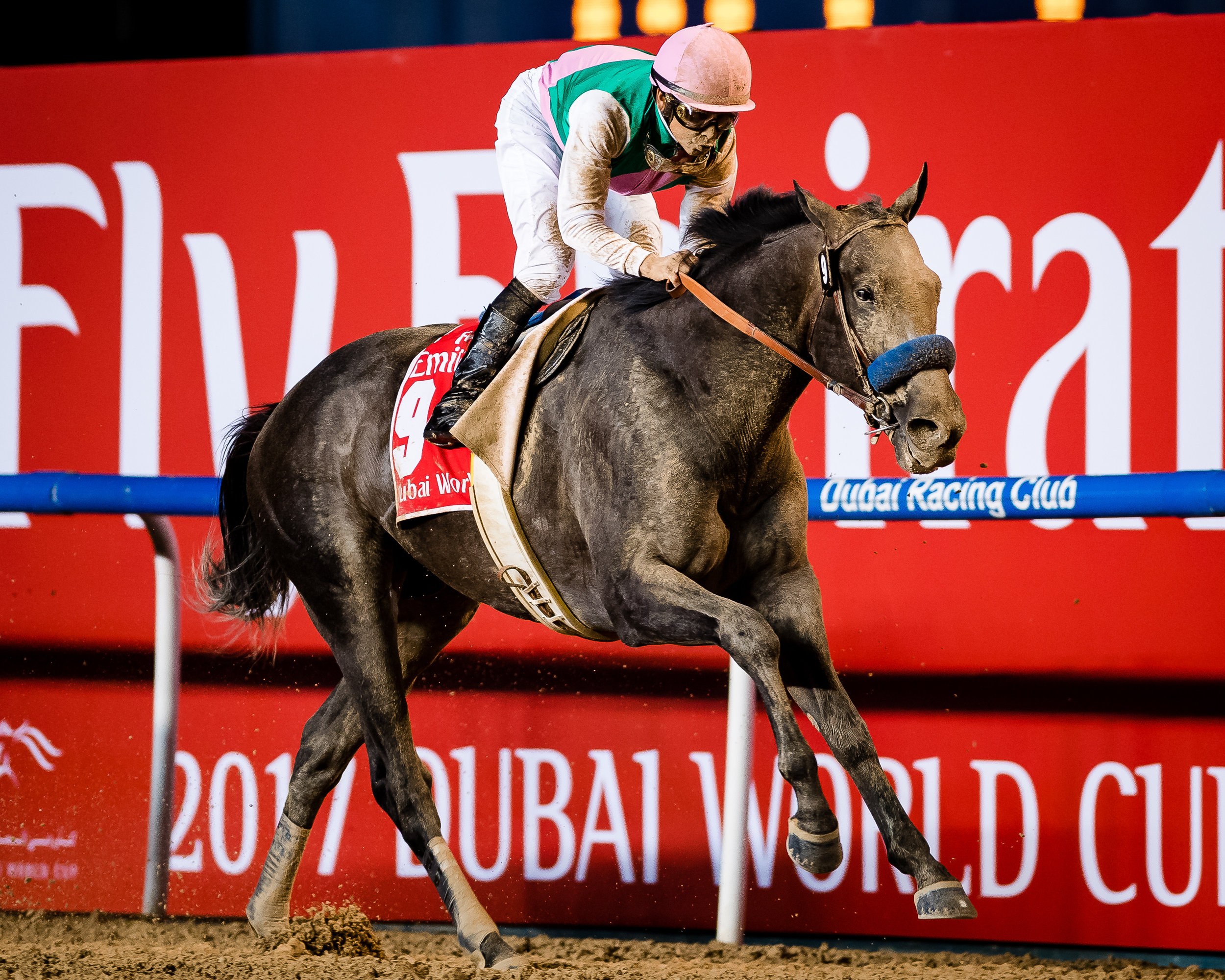International Travel
Traveling equines currently enjoy safer, more comfortable travels whether being hauled by truck or flying the friendly skies. However, due to unavoidable circumstances and worldwide government regulations, shipping companies, trainers and owners are road-weary and jet-lagged.
by Annie Lambert
Since terrorists attacked New York City on September 11, 2001, security measures on all forms of transportation have been stringent, especially for aircraft. The COVID-19 pandemic breaking out in late 2019 raised anxiety and stirred fears, adding even more government regulations to human and animal transport.
Whether you are shipping horses domestically across the United States, internationally to Europe and other far away destinations or between the European Union and Great Britain, nothing is easy. In fact, it has become a paper-heavy, logistical nightmare.
Four-Footed Freight
H.E. “Tex” Sutton worked around the racetrack at an assortment of jobs from a very young age. He began booking horses to ship on railcars in 1954, continuing until prohibitive costs caused him to venture into equine air transport. Tex died long ago, but Tex Sutton Equine Air Transportation is still operating.
In May 2021, the company was unable to renew the lease on their Boeing 727 (cleverly dubbed Air Horse One). After searching unsuccessfully for another aircraft for their equine charters, the strictly domestic company was obliged to book their clients with Federal Express. FedEx bought out one of the original equine freight haulers, Flying Tiger, in 1988.
Airlines all gave the company’s current owner, Rob Clark, the same excuse: They simply didn’t have any extra planes. Any and all aircraft were needed to ship freight. The pandemic had caused a backup in supply chains by truck, sea and air.
“We are still flying as busy as ever,” pointed out Greg Otteson, Sutton sales manager. “We are in between [charter] airplanes right now, so we’re operating using the FedEx system.”
Supply chain woes have scrambled equine transport around the world. Throughout the pandemic, fewer passenger flights caused the freight cargo, normally in the belly of those planes, to be routed to freight-only carriers. The demand for cargo space remains very high.
Kevin Needham
Kevin Needham, managing director of BBA Shipping & Transport Ltd in Newmarket, England, has not noticed any waning demand in shipping horses worldwide. He has experienced many challenges in getting horses from Point A to Point B.
“It’s a definite pandemic consequence,” Needham explained. “Before COVID, people flew around the world really quite regularly and freely in wide-bodied passenger jets. When you’re on an airplane, you sit on the top part of a massive cigar tube; the area below is for freight—full of cargo.”
“When people couldn’t travel, the passenger flights couldn’t travel, [and] the cargo that went in the bellies of those passenger flights got over to the freighter network,” he added. “Flying horses relies on the freighter network because we need the headroom that’s on the main deck. With the complete shutdown in the passenger network, all that freight is going to the freight network.
“Plus, a lot of freight was pulled out of circulation by ridiculous government contracts being paid millions of dollars to fly 50 tons of rubber gloves from China to San Diego, [for example]. They are not in the marketplace, so all the freight rates went up. So, while the numbers of horses stayed relatively stable, the routes they were traveling and the costs to the owners became considerably more expensive.”
Bus Route
Scarlette Gotwals, Brook Ledge
Brook Ledge Horse Transportation has been hauling equines around the United States for more than 55 years. Scarlette Gotwals, DVM, their operations manager, now oversees domestic and international air flights in addition to ground trucking via their wholly owned subsidiary, Horse America.
Brook Ledge Horse Transportation has been hauling Equines around the USA for 55 years
Brook Ledge began using FedEx in 2016. They ship an elite clientele, including many horses on the Kentucky Derby trail, often one or two horses at a time. Unless there are enough horses to charter an entire plane, the equines go where the plane goes, not the other way around. There are few, if any, direct flights.
“FedEx has a published route list,” Gotwals explained. “It is like a bus schedule; you can’t pick your time or route. You have to go when their schedule goes. For example, Tex Sutton [charters] could fly into Ocala Airfield, right next to Ocala Breeders’ Sale, but the closest FedEx [destination] is Orlando [80 miles away].”
These rigid schedules force equine transporters to be creative when planning travel. Finding trips with minimal highway trucking, pre- and post-flight, can be a challenge.
“If you want to go from Gulfstream [Florida] to Oaklawn Park [Arkansas] to run, you basically fly to Memphis, then truck the three hours down to Oaklawn,” Gotwals said. “If you want to go to Belmont [New York], the plane lands in Newark, New Jersey, [over 40 miles away].”
Canada has not reopened to U.S. flights post-pandemic as yet, so Gotwals pointed out horses first fly into airports near the border, then have an initial three-day quarantine, get Canadian papers and finish the trip by truck.
Otteson qualified that Tex Sutton horses going to Vancouver fly into Seattle; those heading to Calgary fly into Great Falls, Montana; and horses traveling to Toronto usually fly into Detroit or Buffalo.
The good news, according to Dr. Gotwals, is how improved ground-trucking horses has become. A lot more is known in keeping horses comfortable and healthy over long hauls. Brook Ledge has transported horses in box stalls from Ocala to California for a number of years.
“When air flights started,” the veterinarian remarked, “we were not as advanced as to how we handled horses on the trucks.” “We’ve learned a lot and there have been published studies. For example, horses do much better when they are loose in a box and able to put their heads down.”
Paperwork Chaos
James Luck
James Luck, the brother of NBC racing analyst Nick Luck, is a co-founder of LG Bloodstock along with partner Lucy Greayer in Berkshire, England. Luck identified a shortage of aircraft and fewer straight-through flights to the United States, but cited his biggest problems presently stem from inter-European travel. Great Britain’s break from the European Union created massive regulation and paperwork.
“With the UK no longer part of the EU, you can’t get anything done over here; it’s ten times as hard as it used to be,” Luck stated. “We have literally ten times as much paperwork as we used to have.
“At the moment, if we want to schedule horses on a flight to New York, we have to truck them from the UK to Liege, Belgium, for a flight to JFK. In the old days, that was a[n] EU paper, one piece of paper to get us to Belgium, and U.S. papers. We stable overnight in Belgium, and off we go. It is now a total of 64 pieces of paper to get that horse to Belgium.”
There are also border control posts and an extensive number of tariffs, taxes and fees when moving goods, including livestock, in and out of the UK. Some of these fees, depending on the owner’s status, would be refunded upon return—not to mention veterinary inspections. As Luck said, “The bureaucracy of the paperwork is unbelievable.”
The stacks of documentation required has doubled Luck’s staffing levels since BREXIT.
“The paperwork all this entails is mind-boggling,” he reiterated. “The bureaucracy and red tape has gone up 20-fold. It is making anyone’s job very, very difficult. And, if a horse gets to [the border check] and there is one digit wrong on one microchip number on 64 pieces of paper, the vet will send that horse home, back to the UK.”
Needham agrees with Luck’s contempt for the added paperwork.
“[BREXIT] made for more paperwork on the European end,” he acknowledged. “They started to treat the UK as if it were the U.S. or Canada. We’ve become a sort of foreign country as far as the EU is concerned.”
Flying Grooms
Needham also cited the COVI pandemic as a source for many of his shipping woes. Different governments panicked in different ways, many with differing restrictions. Equine handlers, called “flying grooms,” became stigmatized by nationality.
“There wasn’t a problem with the horses; it was the problem with the people accompanying the horses,” he noted. “We have this ridiculous situation where, if you have a U.S. passport, you can get into the U.S.; but if you had any other passport, obviously you were a COVID risk, because holding a piece of paper in your hand affects the way a virus can infect you.
“The freighters have to come over with U.S. grooms with the horses, and then the grooms go back to the states. It is a similar situation when flying horses to Hong Kong. Because Hong Kong is now a part of China, it has a zero COVID policy. Foreign people aren’t allowed in, even airline pilots, without two weeks in quarantine. The grooms have to go in on the plane, the horses get off, then the grooms come back out on the same plane they went in on.”
Needham mentioned that Korean International races have been lost because South Korea is another country that has gone with zero COVID regulations. He doesn’t hold much hope that international shipping will ever get back to the days when things were easier to organize.
“In Ireland, France and the UK, we’re racing quite normally and have been for a good while,” he said. “I think that situation is going to stabilize quite quickly. There were plenty of horses in the [2021] Breeders’ Cup. Getting horses to North America is no more complex than it was, and there is an appetite for it.”
Horses must fly in the accompaniment of FedEx-approved flying grooms. Getting approved is a lengthy, in-depth process. The airline requires a minimum of two grooms, whether you are shipping one horse or nine, according to Gotwals.
“The flight grooms that we use have been flying for probably 30 years and are professional handlers,” Gotwals said. “It is about a six- to eight-week process to have a flying groom approved. They have to have an expensive security threat assessment, which is a TSA high-level clearance with background and criminal checks. Unless you have a specific groom that is going to fly with horses three to four times a year, FedEx is not interested in getting them approved.”
Flight Plan
Horsemen and shipping companies continue to plow through paperwork, staff COVID testing and route changes. Other big hits to equine travel plans, however, are inflation and the rapidly rising fuel prices worldwide.
Gotwals opined that she couldn’t imagine it will be long before FedEx adds a fuel surcharge, especially if oil remains over $100 per barrel.
“Everybody is having to add surcharges,” she said. “A tractor-trailer gets five to five-and-a-half-miles to the gallon. When you start to increase prices by a dollar to three dollars a gallon, it means every five miles is an additional three dollars. It adds up very quickly.”
Luck has navigated the pandemic changes but now winces at the energy crisis enveloping Europe.
“The clients are being hit by another whammy, in that fuel prices are going through the roof,” Luck said. “It is literally costing me double to fill up my car. It’s the same with aircraft; it is costing a lot more to purchase aviation fuel. Therefore, it is costing a lot more to fly horses. We’ve recently been hit by every airline we use with substantial rate increases across the board.
Shipping companies seem to agree that demanding regulations and rising costs could somewhat chill equine movement. They also agree it is essential to Thoroughbred racing that equines remain mobile.
“We are a resilient industry,” Luck opined. “We’ve been through a lot of things. I remember after the terrible events of 9/11, we had horses stuck in the UK; it was an awful long time before we could get those horses going again. We’ve been through disease outbreaks and more. But fundamentally, horses will still need to be moved.”
Practical Tips for International Travels
By Denise Steffanus
Horses thrive on a daily routine and do their best when racing in a familiar environment, like a sports team with home-court advantage. But more and more American trainers are trying their hand at racing abroad, in places where racing is very different from what their horses are accustomed to.
Racehorses in Europe don't live and train on the racetrack. They are stabled at training yards, similar to a trainer's private farm in America. Riders hack the horses to grass gallops, sometimes through the nearby town, to get their daily exercise. It is a relaxing, pastoral setting.
When the horses head to the races, they are vanned from the training yard to the racetrack. The disadvantage for an American horse racing for the first time at a European racecourse is it doesn't have the opportunity to train over the track. So on race day, the horse finds itself in strange surroundings without the security of a lead pony, which are not customary in European racing.
Eoin Harty is a fifth-generation Irish trainer now based in California. Under his tutelage, Bill Casner's Well Armed dominated the Group 1 Dubai World Cup in 2009, winning by 14 lengths, the largest margin in the race's history.
Harty described the scene at England's famed Newmarket.
"The town is just basically around different training establishments," he said. "When you go to the track, you might be driving through the town and there's 50 horses walking on the street beside you, and I mean literally walking on the street. Then they just turn off and they go gallop up a hill somewhere. Then they walk back down through the middle of town and go back to their stalls. It takes a little bit of getting used to."
Racetrack configurations
Racetracks in America differ greatly from those in Europe. Here, horses travel counterclockwise on an oval, usually with a dirt surface that the track crew diligently works to keep as flat and even as possible. Turf courses are located inside the dirt tracks, so they are shorter with tighter turns. In Europe, horses race both clockwise and counterclockwise, primarily on turf, traveling up and down grades, and not necessarily in an oval.
England's racecourses are the most interesting. At Goodwood Racecourse in Chichester, the straightaway leads into a loop with sharp turns on a severely undulating surface that sends the horses back over the ground they traversed on the way out. Windsor Racecourse in Berkshire is a figure eight, with horses negotiating both right and left turns. Epsom Downs in Surrey also has right and left turns and a steep downhill turn. At Ascot, some races, such as the Group 1 Queen Anne Stakes, are contested over a straight mile course.
Goodwood
"The hardest thing for me has been dealing with the straightaway, which is such a different race," said trainer Graham Motion, who grew up in Newmarket and apprenticed with Jonathan Pease in Chantilly, France, before coming to the United States. "It's more figuring out the idiosyncrasies of how the race should be run. Because you can't really teach a horse to run straight. It's something they're going to have to adjust to."
Find a local trainer
Harty said American horses tend to get mentally stressed in this strange environment. The way to solve the problem, he said, is to arrive a few weeks earlier and have a local trainer assimilate the horses into his own yard's string so they can train on the same gallops and become accustomed to the local racing environment.
Trainer Art Sherman did exactly that when California Chrome's connections decided to send the horse to Royal Ascot after his second-place finish in the 2015 Dubai World Cup.
"I wasn't familiar with how they train in Newmarket, up and down those hills and different courses," Sherman said. "So I thought it would be better off for the horse to be with somebody who knew everything going on in that area."
California Chrome was placed with Newmarket trainer Rae Guest, but Sherman remained his trainer of record. Guest was tasked with introducing the American Horse of the Year to running clockwise as he prepared for the Group 1 Prince of Wales's Stakes.
"You're not going to go there cold turkey and have them go the wrong way and think they're going to run their best race," Sherman said. "Another factor of going the opposite way is they're going to be on a lead they're not used to running on. That's why you need to train them that [direction] for that type of turn, going from one lead to the other."
Unfortunately, a bruised foot knocked California Chrome out of the race. Sherman visited the horse and said, "He was not a happy camper." His grueling two-year campaign had caught up with him, so California Chrome's connections brought him home for a three-month turnout at Taylor Made Farm in Kentucky.
Trainer Ken McPeek has raced at Ascot and Epsom. In 2004, his Hard Buck finished second in the Group 1 King George VI and Queen Elizabeth Stakes at Ascot. When he built his Magdalena Farm in Lexington, he installed a two-mile European turf gallop up and down the Kentucky hills.
"We train them right-handed and left-handed on gallops here on my farm to prepare them," he said. "If they're going to run at Ascot, we train them right-handed every day. And if they're going to run at Epsom, they go left. And they also get a chance to gallop the hills."
Trainers at the racetrack are not as fortunate.
"I don't know of any track in the States where you can do that," Harty said. "Maybe the racetrack that you're training at would work with you and give you 10 minutes at the end of the day to gallop the wrong way."
Take a Pony
Getting a horse the distance to the starting gate without incident is Motion's concern.
"It's a very free gallop down to the start of the race," he said. "Normally, for the mile at Ascot, the start is a mile away. So you have to gallop a mile down to the start the wrong way up the racetrack. So that can be an issue. Last year McPeek's horse got loose going down to the start."
Daddys Lil Darling, Epsom
Motion was talking about Daddys Lil Darling, who was loping toward the start of last year's Group 1 Epsom Oaks with nine other horses when a loud clap of thunder startled her. The filly ran off with rider Olivier Peslier, eventually parting company with him and running loose until she was caught and scratched from the race.
“I can’t tell you why or how that happened, though I was initially kicking myself that I should have had a pony with her,” McPeek told the Daily Racing Form after the incident.
Lead ponies aren't prohibited in Europe. Trainers just rarely use them.
"Our horses, when they go over there, need that security blanket," Harty said. "If you look at their horses, they send two-year-olds to three different racetracks and three starts and they're in front of a crowd and it doesn't seem to bother them. So I think it's just a different kind of horse with a different kind of upbringing, and that's why they don't use ponies."
A trainer can make a request in advance for permission to use a pony, but has to supply it himself. That often means shipping it to Europe with his other horses.
To further add to the horse's comfort, most trainers take their key personnel with them. Sherman took California Chrome's groom, Raul Rodriguez, and his exercise rider, Dihigi Gladney, to Dubai. Both times, the horse’s regular jockey, Victor Espinoza, was aboard.
Riders up
In the history of the Dubai World Cup, American trainers always have taken the horse's regular jockey with them. Notably, Baffert named Chantal Sutherland-Kruse to ride Game On Dude in the 2012 edition. She is the only female jockey to compete in the auspicious race on United Arab Emirates soil.
Hall of Fame trainer Steve Asmussen said, "With that caliber of horse it would be insulting not to continue to ride who has helped you get there."
In 2008, Asmussen teamed Curlin with Robby Albarado for the win, and Gun Runner had Florent Geroux up for their second-place finish behind Arrogate in 2017.
In Europe, Wesley Ward primarily taps the jockeys with whom he has had the most success in the U.S., among them John Velazquez, Joel Rosario, and Espinoza. Recently, Ward has teamed up over there with champion jockey Frankie Dettori.
"He seems to be able to ride anywhere in the world and adapt to certain situations," Ward said. "He has, in fact, won certain races that I think an American rider or a rider from there wouldn't win, just because he's a phenomenal rider."
Ward was the first American trainer to win a race at Royal Ascot when his Strike the Tiger, with Velazquez in the irons, took the Windsor Castle Stakes by a neck in 2009. Ward returns every year to England and France with a string of horses that rack up impressive wins.
He begins preparing his horses for the midsummer Ascot meet around the first of the year, with a winter break to freshen them. His goal is to give the horses one or two well-spaced prep races in the U.S. before shipping them to England.
"We give them ample time to recover and ample time from their last start here to go there to prepare for those starts. So, essentially, we are running very fresh horses on the day, not tired horses," he said.
Logistics of the trip…
TO READ MORE —
BUY THIS ISSUE IN PRINT OR DOWNLOAD -
Breeders’ Cup 2018, issue 47 (PRINT)
$6.95
Breeders’ Cup 2018, issue 47 (DOWNLOAD)
$3.99
WHY NOT SUBSCRIBE?
DON'T MISS OUT AND SUBSCRIBE TO RECEIVE THE NEXT FOUR ISSUES!
Print & Online Subscription
$24.95










